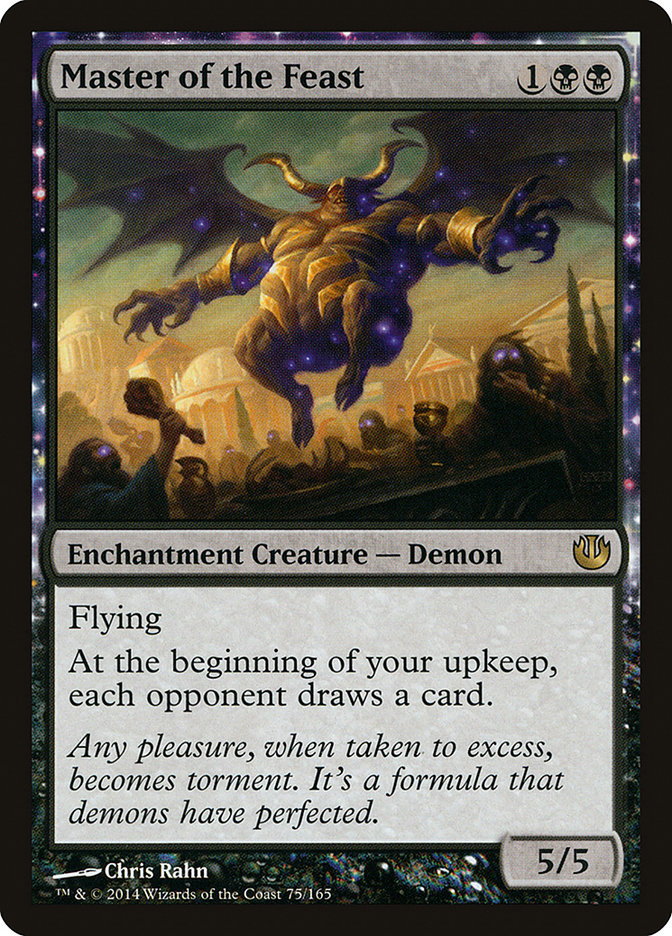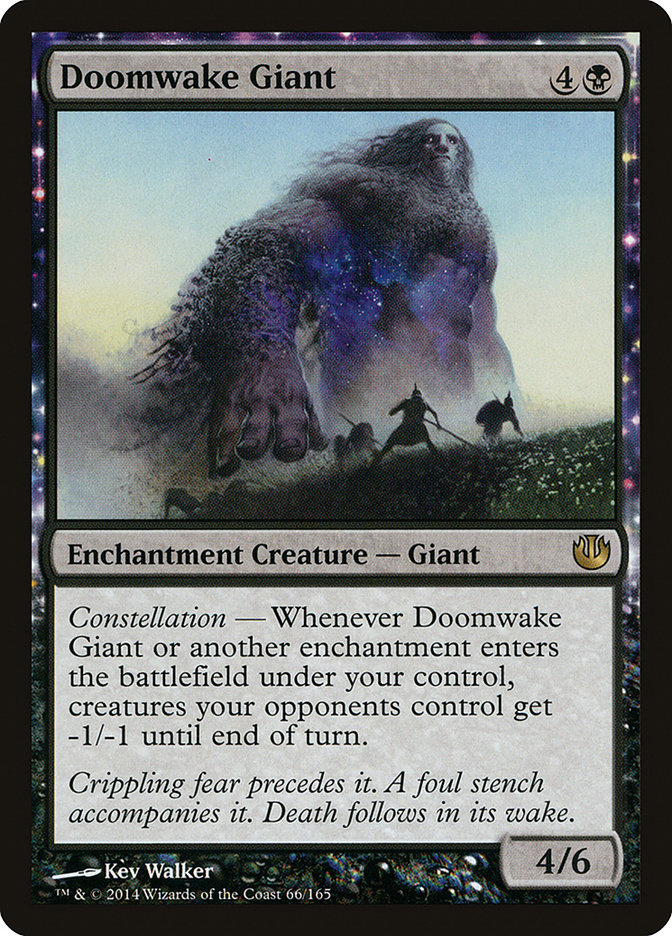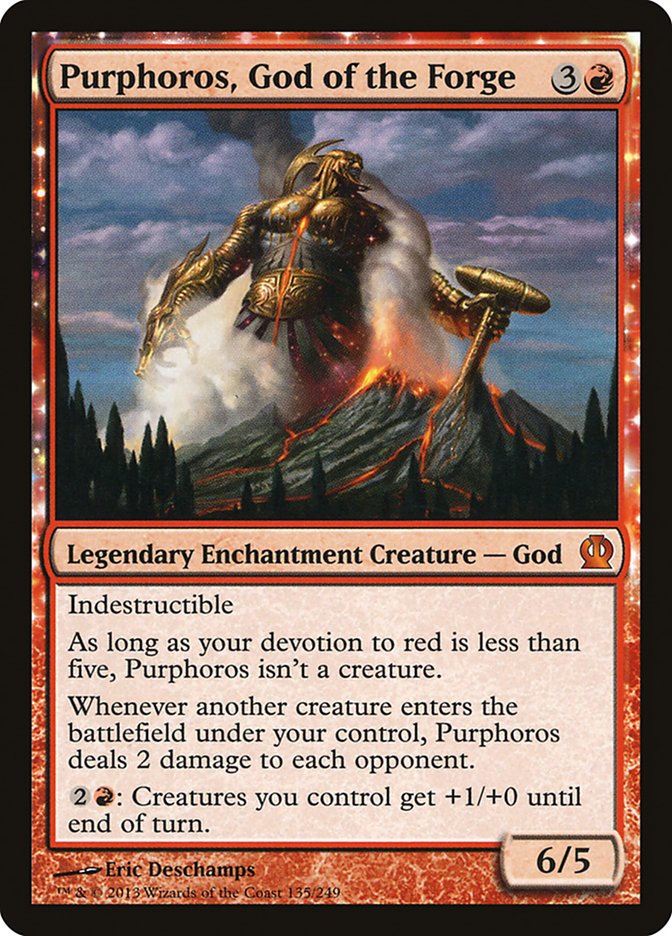The Pro Tour is Magic’s biggest stage, where the world’s best players gather to do battle for the game’s biggest prize. $40,000 is a nice chunk of change,
and everyone who came to Atlanta last weekend for Pro Tour Journey into Nyx was thinking that maybe, just maybe, they could be the one hoisting the trophy
when all the dust settled.
Fortunately for StarCityGames.com, our own Patrick Chapin took down the event. Unfortunately for me and my cohorts, it was not to be for The Lost Boys. But
we did put up a fight. While Brad Nelson refuses to accept “The Lost Boys” as our team name, we love him anyway. The Lost Boys put five of our six members
into the Top 50 at Pro Tour Journey into Nyx, including Michael Majors in 16th place. And as for the entirety of our roster:
Brad Nelson: 37th
Brian Braun-Duin: 44th
Andrejs Prost: 48th
Jasper Johnson-Epstein: 173rd
Michael Majors: 16th
Todd Anderson: 30th
Everyone on the team who ended up playing the Naya deck ended up making it into the Top 50 at the Pro Tour, but that’s the end of the story. How did we get
here?
For this Pro Tour, I wanted to try forming my own team with friends I cared about and whom I knew would dedicate themselves to the grind as much as I
would, if not more. While we wouldn’t have the manpower to play a hundred matches of each matchup in the format, we would be able to test enough to give us
a better idea of what to expect, and ultimately shape our final deck into a product I would be happy with playing at the tournament.
And what we got was exactly that, though it didn’t really feel like it at the time.
There comes a point in every testing process where you feel like your results have become inbred. You start to wonder if the decks you’re testing against
are even going to show up at the tournament, let alone take it by storm. Throughout the two weeks we spent brewing, drafting, and battling, we probably
constructed fifteen or more different archetypes, with a lot of variations on how the decks were constructed.
We had the BUG deck that both Pantheon and CFB brought to the tournament. We had the W/U Heroic deck. We had every combination of Sylvan Caryatid into
Courser of Kruphix. But what else was there to figure out?
Early in our testing process, it was clear to us that Sylvan Caryatid into Courser of Kruphix was going to be the defining core to any green deck.
Regardless of what other green cards were in the deck, these two were essential. The card advantage gained with Courser of Kruphix as well as the Hexproof
mana accelerator would give most green decks the consistency and speed to compete with the aggressive decks or outpace the control decks.
What we didn’t expect was that aggressive decks would ultimately fall in the face of such a powerful core. Courser of Kruphix was not only a card advantage
engine, it was a body with enough power and toughness to invalidate most aggressive strategies, leaving most aggro players without any other option than
going bigger than their opponents. The incremental lifegain, coupled with cheap spot removal, pushed most aggressive decks out of the format, though that
doesn’t mean they didn’t show up at the tournament.
Mono-Black Aggro was one of the biggest decks on Magic Online leading up to the tournament. Bestow gave the deck some added utility in the later turns of
the game, giving your smaller creatures a boost and giving you something to do with mostly dead mana. One card that was severely overrated was Master of
the Feast, and I think that card actually caused the deck to fail when it was such a powerful deck before Journey into Nyx was released.
I figured out early on that Master of the Feast was not a card I ever wanted to play with when I was actively happy when my opponent cast it. Yes, it could
deal lethal in just four attacks, but giving your opponents card advantage is just miserable when every black deck has access to a full complement of
Hero’s Downfall and Silence the Believers, two cards we knew were the heart of every black strategy. When your opponent can free-roll kill your Master of
the Feast on your turn, the odds of you winning the game are pretty low. Add to this the fact that nearly every single deck has an answer to Master of the
Feast, and you understand exactly why it isn’t very good.
There was a point in testing with Banishing Light where I wondered if it was correct to kill my own card, just so I could give my opponent back their
Master of the Feast so I could draw some more cards. When that is an option worth considering, that’s when you know it probably shouldn’t be in your deck.
Mono-Red Aggro was another deck we built pretty early on, and it actually had reasonable success. We tried versions with Flamespeaker Adept, as well as
hyper-aggressive variants that played zero spells that cost more than two mana. Both were actually pretty powerful, and were early considerations to be
front-runners for us, but the draw of Courser of Kruphix was just too much.
It was evident fairly early in testing that Elspeth, Sun’s Champion was the “card to beat” in the format. It does cost a lot of mana, but that doesn’t seem
to be an issue when there are so few aggressive decks running around. Every single deck we built had to have an answer to it, or find a way to invalidate
it as quickly as possible. Hero’s Downfall was a must for any black deck, simply because it was the most efficient way to deal with Elspeth permanently.
Banishing Light had a major drawback, in that they could easily just kill the Banishing Light and get it back. With so many enchantments in the format, we
felt like it was pretty easy to come to the realization that Deicide and Unravel the Aether were maindeckable cards, which makes Banishing Light all that
much worse.
But just killing Elspeth isn’t always enough. The tokens she leaves behind, even after a Hero’s Downfall, can peck away at your life total while you
struggle to find a way to win the game. And if she was ever in play for more than a turn, six tokens is a lot of baggage to handle. What we did find was
this little gem:
Doomwake Giant was a fine creature on its own. It helped fight against aggressive creature-based decks, while also giving you a way to invalidate the
tokens that Elspeth left behind. And if you just so happened to have five power in play before you cast the Doomwake Giant, Elspeth was not long for this
world. In our closing days of testing, Doomwake Giant was at around two copies in every single black deck we produced, just because of how well it matched
up against Elspeth. What this also meant was that we wanted more enchantments in our deck, making threats like Boon Satyr more palatable.
But ultimately, we felt like having a midrange or control deck that lacked Elspeth, Sun’s Champion just wasn’t powerful enough to compete with the decks
that did have them. We had the right answers, but those answers were still less powerful than the threats they were supposed to beat, leaving a bad taste
in our mouth whenever we didn’t draw Doomwake Giant or Hero’s Downfall. If our opponents had an active Elspeth for more than a turn or two, the game was
almost always over.
With that in mind, we worked pretty hard on a Naya Midrange deck over the last few days, simply because we felt it was the most powerful proactive strategy
in the format that contained Elspeth. Ramping into Elspeth was pretty easy to do with Sylvan Caryatid and Voyaging Satyr, but you needed some big threats
to beat the decks featuring Silence the Believers. This is what led us to playing four copies of Xenagos, the Reveler alongside our Elspeths.
While we were not able to trump the mirror all that easily, our deck had better threats against removal-dense opponents. Xenagos was an all-star, and I
used all of his abilities multiple times throughout the tournament. Let me tell you, using Xenagos as a Seething Song was pretty absurd on occasion, giving
you enough mana to cast and monstrous Stormbreath Dragon in the same turn. Many an opponent fell to this powerful combination, because most decks lacked a
significant sweeper effect.
Polukranos was a card we tested heavily in the early go-around, but our fear of midrange strategies pushed us off of him and more towards Xenagos. We also
felt like Polis Crusher gave our deck a bit of resiliency against removal like Banishing Light, but also gave us some blowout potential against Mono-Black
Aggro and other decks featuring a ton of enchantments. The fact that Courser of Kruphix can’t block Polis Crusher was also a plus, allowing you to pressure
an opponent’s Planeswalker unless they felt it necessary to chump block with their Sylvan Caryatid.
Our sideboard plan featured one of my favorite combinations I’ve ever played in a tournament:
We called it the Happy Birthday Combo. Sixteen Candles. And boy was it a blowout whenever it
came together. The heart of the reason for playing Revel of the Fallen God was because we needed a trump whenever we would tend to flood out. This would
happen quite regularly against other midrange and control decks, because Courser of Kruphix would regularly sit in play for multiple turns while they were
forced to deal with our other problematic threats.
Stormbreath Dragon, Elspeth, Xenagos: these were all threats that hit much harder and required an answer almost immediately. If they weren’t able to deal
with them, then they were going to lose in just a few turns. When Courser is sitting in play during those turns, you’re able to hit most of your land
drops, but you need something to actually do with that mana. We found that Gruul Ultimatum fit the curve nicely.
While making four 2/2 creatures for seven mana isn’t all that spectacular, you have to remember that you’re pressuring them throughout the game with
various threats that tend to leave more creatures behind, even when they’re killing the source of those creatures. The fact that those Satyr tokens have
haste is a big deal, as there aren’t many ways in the format to kill them all at once. Bile Blight was an issue at times, but the card is absurdly bad
against the rest of the deck, and we figured people would generally sideboard all of their copies out. And if they didn’t, there was always the chance
they’d tap out for a removal sell or Prognostic Sphinx and just die on the spot.
Most midrange decks don’t have the same kind of reach as this particular Naya build, as our cheap removal spells also double as burn spells. I can’t tell
you how often I got my opponent down to five or six life, only to have them die to my Magma Jets and Lightning Strikes. Being able to use Magma Jet to find
the final points of damage was also huge, as scrying away two lands in the late game is almost exactly the same as drawing two cards. We found in testing
that our main way to finish off the grindy control and midrange decks was to just burn them out after we hit them with some tokens or Dragons. They could
take a few hits from our threats, but that would always leave them vulnerable in the end.
Here is the final list we ended up using for the Pro Tour, though our lists ended up being off by just a few cards:
Creatures (18)
Planeswalkers (8)
Lands (24)
Spells (10)

What I learned from this tournament is that it is much easier to go into a Pro Tour planning on piloting a proactive strategy rather than a control
strategy. Up until just a few days before the event, I was virtually locked on an Esper Control list that I felt was quite powerful, but was ultimately
swayed due to getting destroyed by the Naya deck. I could usually deal with most of their threats in time, but the games would usually end when my opponent
would draw their third or fourth burn spell to finish the job. Without something like Courser of Kruphix to gain me small edges in life, I was susceptible
to these kinds of finishers, and I couldn’t imagine playing a control deck in a Pro Tour that ended up losing because the midrange decks played Magma Jet.
Proactive decks are much stronger in smaller, unsolved formats because they give you the driver’s seat. If you’re the one guiding the action, you can put
your opponent to some tough decisions throughout the game. If they don’t have the right answer at the right time, they could just lose on the spot. We
found that most decks in the format would be quite adept at putting pressure on the opponent, and few decks could handle the wide range of threats that the
format could produce. Even the control decks were generally geared more towards ramping into gigantic, tough-to-beat threats like Prognostic Sphinx, so why
would you ever want to sit back on your mana instead of just putting another big threat into play?
One major mistake we made in testing was dismissing the power of Thoughtseize too early. Our initial top deck was Mono-Red, which made a lot of things feel
pretty bad, including Thoughtseize. We figured that if Mono-Red was a real entity at the tournament, the downside of playing Thoughtseize was too big. I
don’t even remember if we had Thoughtseize in our BUG deck’s maindeck before we ended up switching to Naya, but I do remember the sour taste that
Thoughtseize left in my mouth whenever I had to cast it against an opponent who was trying to play one-drop creatures.
And that is the kind of inbred testing that can happen. You have to approach each tournament from multiple angles, and we basically wasted an entire
weekend testing black decks that didn’t have Thoughtseize in them. While we found them to be pretty mediocre, that is probably because Thoughtseize was not
there to help fight against all of the midrange and control decks. Once we started adding Thoughtseize back into the mix, those strategies became much
stronger, but we had tunnel vision at the time and just couldn’t imagine playing Thoughtseize in a format filled with Mono-Red.
Hilariously enough, I didn’t see a single Mono-Red deck at the tournament, but that doesn’t mean it wasn’t a good choice. We had a lot of ways to get
around Courser of Kruphix, and I think that is a great place to be as an aggressive deck. I wouldn’t have even minded playing Mono-Red at the Pro Tour, but
there is a cost to playing decks that can just fold to themselves. This is one of the reasons why we didn’t play W/U Heroic, even though it was one of our
strongest decks in testing. In a vacuum, these strategies are often powerful, but you have to expect your opponents to be prepared for them. We expected a
ton of Glare of Heresy, as well as every other removal spell in the book. Aggressive decks always get much worse after sideboard, because the opponent will
usually get access to some big hoser effect.
For the next Pro Tour, I am looking forward to doing something similar as a testing group that we did for this one. I was very happy with our results as a
team, though I did not finish the tournament as strongly as I had started it. I finally 3-0’ed a Pro Tour draft for the first time in my career, and that
was a great starting point for Constructed, where I generally do much better than Limited. I know what I need to work on as a player, and I know what we
need to work on as a group, and I expect big things for us in the future.
The Lost Boys have been found, and we’re ready for more.




